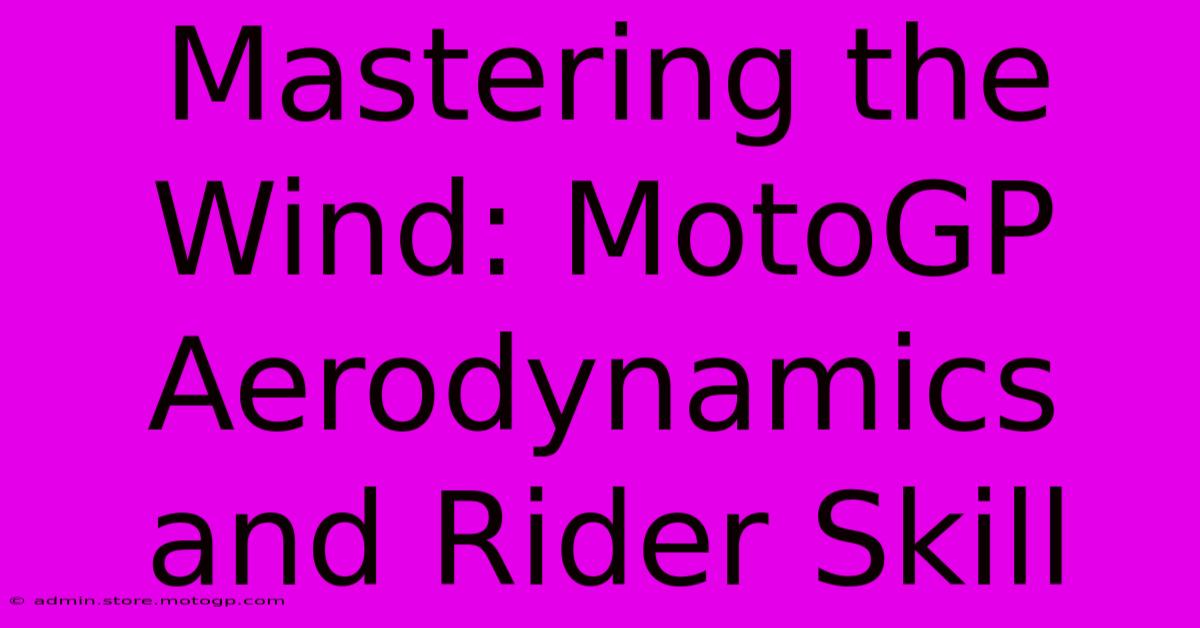Mastering The Wind: MotoGP Aerodynamics And Rider Skill

Table of Contents
Mastering the Wind: MotoGP Aerodynamics and Rider Skill
MotoGP racing isn't just about raw horsepower; it's a delicate dance between man and machine, a symphony of speed, precision, and aerodynamic mastery. While the roar of the engines captivates the crowds, the subtle interplay of aerodynamics and rider skill is the true conductor of this high-octane orchestra. This article delves into the crucial role aerodynamics plays in MotoGP, and how riders must adapt and master these forces to achieve victory.
The Science of Speed: Aerodynamics in MotoGP
Modern MotoGP bikes are marvels of engineering, sculpted to slice through the air with minimal resistance. Every curve, every winglet, every fairing detail is meticulously designed to optimize aerodynamic performance. But it's not just about speed; it's about stability and control at speeds exceeding 200mph.
Key Aerodynamic Components:
- Fairings: The bodywork of the bike, designed to minimize drag and manage airflow around the rider and engine.
- Winglets: Small wings positioned strategically on the fairing, generating downforce to improve stability at high speeds and during cornering. These are crucial for maintaining traction and preventing wheelspin.
- Aerodynamic Appendages: Various smaller components, constantly evolving, designed to manipulate airflow and improve stability in specific areas. These can include small fins, deflectors, and other carefully placed aerodynamic aids.
The Rider's Role: More Than Just Bravery
While the technology is impressive, it's the rider who ultimately harnesses the power of aerodynamics. Their skill isn't just about speed and braking; it’s about understanding and reacting to the forces acting upon them and the machine.
Mastering Aerodynamic Forces:
- Body Positioning: Riders constantly adjust their body position to minimize drag and maximize downforce. Tucking in on straights, leaning into corners—these subtle shifts are crucial for maintaining control and speed.
- Brake Management: Aerodynamics play a significant role in braking performance. Riders need to anticipate the aerodynamic forces acting on the bike to prevent instability and maintain control during braking zones.
- Smoothness and Precision: Sudden movements can disrupt the delicate balance of aerodynamic forces. Smooth inputs and precision control are essential for maintaining stability and maximizing the bike's potential.
The Human Factor: Adapting to Changing Conditions
Aerodynamic performance is not static; it's affected by track conditions, weather, and even the rider's own style. The rider must constantly adapt their technique to optimize performance under these variable conditions. A rider's feel for the bike, their understanding of aerodynamics, and their ability to adapt is a critical component to success.
The Constant Evolution: Aerodynamics and Technological Advancements
MotoGP is a breeding ground for innovation. Teams are constantly researching, developing, and testing new aerodynamic solutions. The ongoing development of Computational Fluid Dynamics (CFD) and wind tunnel testing allows teams to refine their designs with ever-increasing precision. This constant push for aerodynamic advantage drives competition and pushes the boundaries of motorcycle technology.
Conclusion: A Perfect Harmony
MotoGP showcases a remarkable interplay between cutting-edge technology and human skill. Mastering the wind—understanding and controlling the aerodynamic forces acting upon the bike—is paramount for success. The rider's intuitive understanding of these forces, coupled with the ever-evolving sophistication of aerodynamic designs, defines the thrilling spectacle that is MotoGP. The future promises even more refined aerodynamic solutions, pushing the limits of speed and precision even further.

Thank you for visiting our website wich cover about Mastering The Wind: MotoGP Aerodynamics And Rider Skill. We hope the information provided has been useful to you. Feel free to contact us if you have any questions or need further assistance. See you next time and dont miss to bookmark.
Featured Posts
-
Moto2 Specs Achieving Peak Performance
Feb 18, 2025
-
Push Your Limits Austin Sprint Race Time Challenge
Feb 18, 2025
-
Austin Sprint Race Time Environmental Factors And Their Impact
Feb 18, 2025
-
Step Up Your Game Moto Gp 23 On Ps 5
Feb 18, 2025
-
The Ultimate Formula 1 Experience Starts With Parking
Feb 18, 2025
